2020 Volume 61 Issue 2 Pages 375-380
2020 Volume 61 Issue 2 Pages 375-380
The coarsening kinetics of a fine C15–Al2Ca Laves phase with a plate-like morphology precipitated within the primary α-Mg grains were investigated for Mg–5Al–1.5Ca alloy aged at 523 K. The Al2Ca precipitate coarsened as its coherence was retained in the aging time below 300 h, and a quantitative relationship was obtained between precipitate length (l) and aging time (t) as l ∝ t0.23. However, the α/C15 coherent interface changed into a semi-coherent interface by introduction of misfit dislocations on the planar surface of the precipitates in the aging time above 300 h, which resulted in the promotion of Al2Ca coarsening. The Al2Ca phase was assumed to precipitate through a nucleation and growth mechanism rather than spinodal decomposition, and its coarsening was explained using the terrace-ledge-kink mechanism. The result shows that the aspect ratio of the Al2Ca precipitates was predominantly determined by the aging temperature, and it decreased at higher aging temperatures.
This Paper was Originally Published in Japanese in J. Japan Inst. Met. Mater. 83 (2019) 282–287.
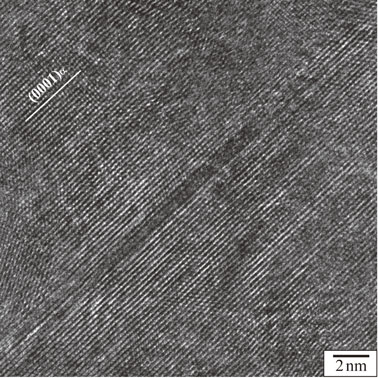
Fig. 2 HRTEM image of coherent C15–Al2Ca precipitate observed in the Mg–5Al–1.5Ca alloy aged at 523 K for 10 h, taken with $\textbf{B} = [11\bar{2}0]_{\alpha }$.
Magnesium alloys are the lightest structural metallic materials and are gaining interest for use in the automotive and aerospace industries, where they are instrumental in increasing fuel efficiency and minimizing carbon dioxide emissions.1,2) Due to its low density and low cost, calcium is a promising substitute for rare-earth elements for improving the mechanical strength of Mg–Al alloys. The resultant Mg–Al–Ca alloys usually exhibit excellent non-flammability properties. In the last decade, significant efforts have been directed at developing high-strength magnesium alloys.3–5) Accordingly, cost-effective Mg–Al–Ca alloys with excellent room-6,7) and high-temperature strength8–11) have been successfully developed. The microstructures of die-cast Mg–Al–Ca alloys generally exhibit a primary α-Mg phase with a dendritic morphology and a eutectic lamellar structure in the interdendritic regions, where calcium is super-saturated in the primary α-Mg phase.12,13) When Mg–Al–Ca alloys are subjected to aging treatments in the temperature range of 448–623 K, a fine C15–Al2Ca Laves phase with a plate-like morphology precipitates along the (0001)α basal plane of the primary α-Mg grain. The low- and high-temperature strength of the material is then increased via the precipitation strengthening of the plate-like fine C15–Al2Ca Laves phase.14,15)
The plate-like fine C15–Al2Ca phase precipitated during the aging treatment of Mg–Al–Ca alloys has the following crystallographic orientation relationship with respect to the α-Mg matrix: (111)C15 // (0001)α and $[01\bar{1}]_{\text{C15}}$ // $[0\bar{1}10]_{\alpha }$, where the crystal planes having the greatest planar density in both phases are parallel to each other.14) Because the thickness of the plate-like fine C15–Al2Ca phase is extremely thin, the precipitate thickness is difficult to identify using conventional transmission electron microscopy (TEM). In a previous study, Mg–Al–Ca alloy (Mg–5 mass% Al–1.5 mass% Ca die-cast alloy, hereafter denoted as Mg–5Al–1.5Ca alloy) was subjected to an aging treatment under an over-aging condition at 523 K for 100 h. The morphology and thickness of the resultant C15–Al2Ca Laves phase precipitated in the primary α-Mg grains were then investigated using high-resolution transmission electron microscopy (HRTEM).16) As a result, the following points were clarified on the fine C15–Al2Ca precipitates: (i) the fine C15–Al2Ca precipitate has a hexagonal plate-like morphology whose planar surface is parallel to the (0001)α basal plane and the sides of the hexagonal plate are parallel to the $\{ 11\bar{2}0\} _{\alpha }$ second columnar plane of the α-Mg matrix, (ii) the thickness of the fine Al2Ca precipitate, which is equal to six layers of the (111)C15 plane composed of Ca atoms in the C15 crystal structure, is ∼1.5 nm, and (iii) coherence between the C15–Al2Ca precipitate and the α-Mg matrix is achieved on both the planar surface and the sides of the hexagonal plate. Hence, information concerning the coarsening rate and coherence of the C15–Al2Ca precipitate during aging treatments is indispensable for quantitative evaluation of the precipitation strengthening for Mg–Al–Ca alloys derived from fine C15–Al2Ca precipitates. This study aims to quantitatively investigate the precipitation microstructure of the plate-like fine C15–Al2Ca phase under an over-aging condition at 523 K for the Mg–5Al–1.5Ca alloy and to evaluate the coarsening rate of the plate-like C15–Al2Ca precipitate based on coherence.
Mg–5Al–1.5Ca (mass%) alloy was used in this study, and its composition is shown in Table 1. The alloy plates of 50 × 70 × 3 mm3 were produced using a cold chamber die-cast machine in 1 vol% SF6–99 vol% CO2 atmosphere at casting and die temperatures of 993 K and 473 K, respectively. The die-cast samples were subjected to aging treatment in air at 523 K for 3.6 × 104–1.1 × 107 s (10–3000 h) and at 573 K for 1 h. Thin films cut from the aged specimens were shaped into disk samples with a diameter of 3 mm, and the thickness of the samples was maintained at 120 µm by mechanical polishing. The samples were then electrolytically polished using a standard twin-jet polisher and a solution of 10 vol% HClO4–90 vol% C2H5OH. The polishing conditions were set to 243 K and 25 V, and the resultant polishing current was ∼0.1 A. The perforated foils were examined using TEM (JEOL JEM-2010) and HRTEM (FEI Titan3 G2 60-300) operating at 200 kV and 300 kV, respectively.

The TEM images of the Mg–5Al–1.5Ca alloy aged at 523 K for 30–3000 h, corresponding to its over-aged conditions,15) are shown in Fig. 1. The incident beam direction is $\textbf{B} = [11\bar{2}0]_{\alpha }$ and the reciprocal lattice vector is g = 0002α, at which the C15–Al2Ca precipitates are most clearly observable.17) It is observed that numerous Al2Ca phases with lengths of ∼20 nm is uniformly precipitated along the (0001)α basal plane of the primary α-Mg phase for the alloy aged for 30 h (Fig. 1(a)), which corresponds to the early stage of the over-aged condition. Moreover, the strain contrast associated with the individual precipitate is clearly visible, as indicated with arrowheads in Fig. 1(a), which is indicative of the coherent precipitation of the Al2Ca phase with respect to the α-Mg matrix. The precipitation density of the Al2Ca phase was measured as 6.1 × 1014 m−2. The length of the precipitates for the alloy aged for 300 h (Fig. 1(b)) has slightly increased relative to that for the alloy aged for 30 h. However, the precipitation density has reduced to 4.1 × 1014 m−2. In addition, the strain constant can be clearly observed around the precipitates as indicated with arrowheads, which suggests that the coherence between the Al2Ca precipitate and the α-Mg matrix is retained for 300 h at 523 K.
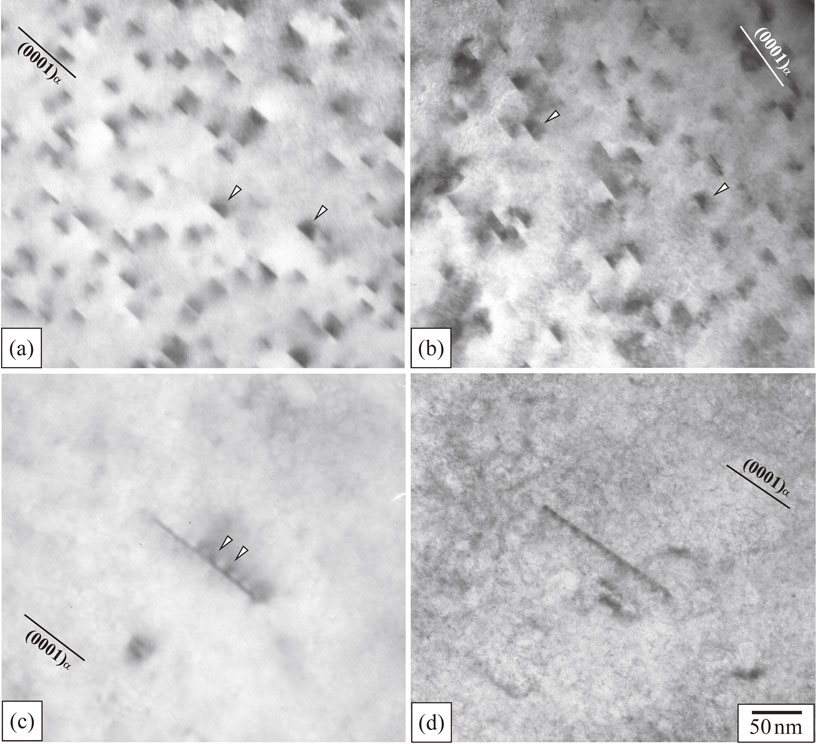
TEM BFIs of the Mg–5Al–1.5Ca alloy aged at 523 K for (a) 30 h, (b) 300 h, (c) 1000 h, and (d) 3000 h, taken with $\textbf{B} = [11\bar{2}0]_{\alpha }$, g = 0002α. The strain contrast around the C15–Al2Ca precipitates is indicated with arrowheads in (a), (b), and (c).
As the aging time increases to 1000 h (Fig. 1(c)), the length of the C15–Al2Ca precipitates increases substantially to ∼130 nm while the precipitation density decreases markedly. The region where the strain contrast is observable becomes limited as denoted with arrowheads in Fig. 1(c), as different as the alloys aged for 30 and 300 h. For the specimen aged for 3000 h (Fig. 1(d)), no strain contrast is detected around the Al2Ca precipitate. However, the precipitate is located on the (0001)α basal plane of the α-Mg matrix. Based on these results, following points were clarified for the microstructure evolution during the over-aged condition at 523 K: (i) when the aging time is below 300 h, the Al2Ca precipitates coarsen as its coherence with respect to the α-Mg matrix is retained; (ii) the coherence between the Al2Ca precipitate and the α-Mg matrix reduces and coarsening significantly increases with increasing aging time from 300 h to 1000 h, thereby resulting in the marked reduction of the precipitation density of the Al2Ca phase; (iii) the Al2Ca phase precipitates incoherently with respect to the α-Mg matrix at the aging time of 3000 h.
3.2 HRTEM imageThe HRTEM image of the C15–Al2Ca precipitate for the Mg–5Al–1.5Ca alloy peak-aged at 523 K for 10 h is shown in Fig. 2. The length of the Al2Ca precipitate is 12 nm and the thickness corresponds to three stacks of the (0001)α basal plane of the α-Mg matrix. The planar surface of the Al2Ca precipitate is relatively linear, which is parallel to the (0001)α basal plane of the α-Mg matrix. The length of the Al2Ca precipitate becomes 24 nm with retaining coherence for the specimen aged for 100 h (Fig. 3), which is twice as long as the length of the specimen aged for 10 h. Additionally, the planar surface of the Al2Ca precipitate was relatively linear, which is parallel to the (0001)α basal plane of the α-Mg matrix, similar to the case of the specimen aged for 10 h.

HRTEM image of coherent C15–Al2Ca precipitate observed in the Mg–5Al–1.5Ca alloy aged at 523 K for 10 h, taken with $\textbf{B} = [11\bar{2}0]_{\alpha }$.
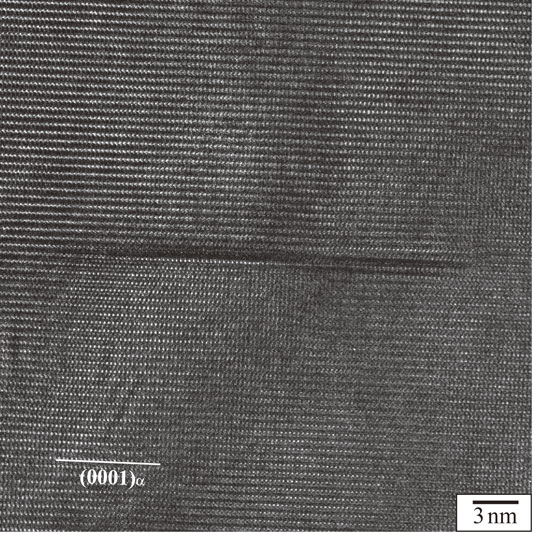
HRTEM image of coherent C15–Al2Ca precipitate observed in the Mg–5Al–1.5Ca alloy aged at 523 K for 100 h, taken with $\textbf{B} = [11\bar{2}0]_{\alpha }$.
The length of the C15–Al2Ca precipitate substantially increases to 174 nm for the specimen aged for 1000 h in which the coherency between the C15–Al2Ca precipitate and the α-Mg matrix is partially collapsed (Fig. 4(a)). Although the precipitate is located along the (0001)α basal plane of the α-Mg matrix, the linearity of the interface between the precipitate and the matrix degrades. The enlarged HRTEM image of the region surrounded by square in Fig. 4(a) is shown in Fig. 4(b). The spots with dark contrast are detected periodically on the planar surface of the Al2Ca precipitate, as indicated with arrowheads. For the specimen aged for 1000 h, the coherence between the Al2Ca precipitate and the α-Mg matrix cannot be retained and misfit dislocations are introduced on the planar surface of the Al2Ca precipitate, which results in the evolution of the coherent interface to a semi-coherent interface.
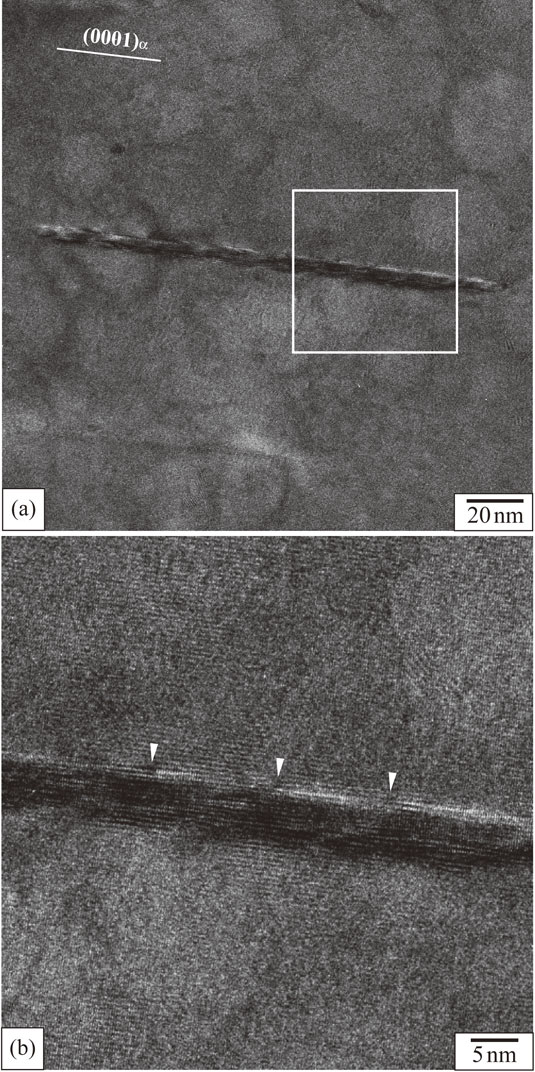
HRTEM image of semi-coherent C15–Al2Ca precipitate observed in the Mg–5Al–1.5Ca alloy aged at 523 K for 1000 h, taken with $\textbf{B} = [11\bar{2}0]_{\alpha }$ (a). The area surrounded by square in (a) is magnified in (b). The spots with dark contrast on the planar surface of the precipitate are indicated with arrowheads.
The length of the C15–Al2Ca precipitate for the specimens aged at 523 K was quantitatively evaluated against aging time. The length of the Al2Ca precipitate was measured from the TEM and HRTEM images, and the resultant length distribution was summarized as a histogram for every aged specimen. The result for the alloy aged for 30 h is shown in Fig. 5 as a typical example, where the number of measured Al2Ca precipitates is 91. The length of all the Al2Ca precipitates ranges between 15 and 45 nm. When the data of the precipitate length are classified into 5 nm intervals, the maximum 32 data are located in the range of 25–30 nm. The number of precipitates continuously decreases with the distance from the range of 25–30 nm. The average value of the precipitate length was evaluated to be 28.1 nm for the alloy aged for 30 h.
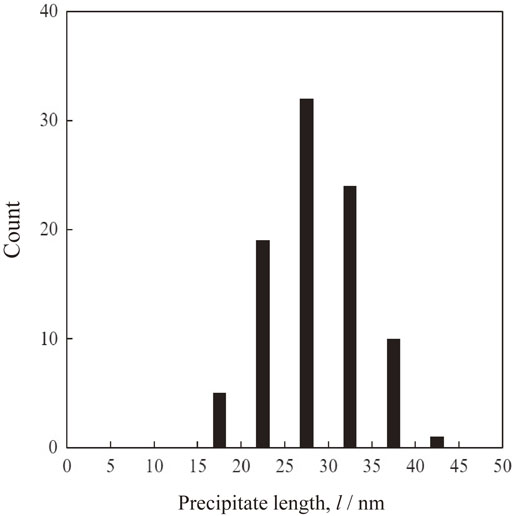
Size distribution of C15–Al2Ca precipitates observed in the Mg–5Al–1.5Ca alloy aged at 523 K for 30 h. The number of measured precipitates is 91.
Furthermore, the average length of the C15–Al2Ca precipitates for the alloys aged at 523 K for 3.6 × 104–1.1 × 107 s (10–3000 h) was evaluated against aging time. This result with the coherence information for each specimen is shown in Fig. 6. For the alloy aged for 10 h, which corresponds to the peak-aged condition at 523 K, the average length of the Al2Ca precipitates is 19.3 nm. The average length increases continuously with increasing aging time and reaches to 42.1 nm at 300 h. Moreover, the length of the precipitates increases abruptly to 142 nm at 1000 h and finally reaches to 299 nm at 3000 h. Meanwhile, the thickness of the thin films used for the TEM and HRTEM observations is ∼100 nm. When the plate-like Al2Ca precipitate is sufficient long for comparison with the thickness of the thin films, the evaluated precipitate length can be shorter in the case where the longest part of the plate-like precipitate deviates from the thin films.
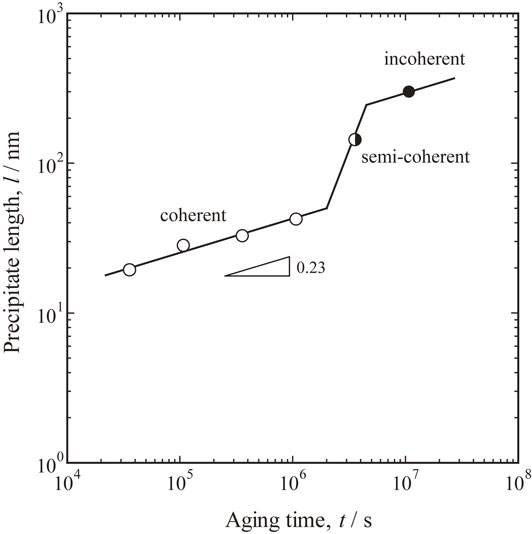
Plots for the Mg–5Al–1.5Ca alloy of the C15–Al2Ca precipitate length vs. aging time at 523 K.
In the aging time below 300 h where the C15–Al2Ca phase precipitates coherently with respect to the α-Mg matrix, a quantitative relationship was obtained between precipitate length (l) and aging time (t) as l ∝ t0.23. The exponent is apparently smaller than 0.33,18–20) in which a precipitate coarsens along the Ostwald ripening.21,22) When the coherence is retained, coarsening of the Al2Ca precipitate would be difficult due to the elastic constraint derived from the coherent strain. Therefore, the gradient of the l–t curve was considered to be smaller than 0.33.23) Figure 6 shows that the gradient of the l–t curve increases between 300 h and 1000 h. The abrupt increase in l is caused by the breakdown in coherence between the Al2Ca precipitate and the α-Mg matrix, thereby resulting in its release from the elastic constraint due to the coherent strain.
3.4 Coarsening mechanism of the C15–Al2Ca precipitateThe crystal structure of the Al2Ca precipitate is a cubic C15 structure, while the α-Mg matrix has a hexagonal hcp (A3) structure. Because the crystal system of the precipitate differs from that of the α-Mg matrix, the Al2Ca phase of the alloy is assumed to precipitate through a nucleation and growth mechanism rather than spinodal decomposition. As shown in Fig. 7, the precipitation and coarsening of the Al2Ca phase during the aging treatment for the alloy is explained using the terrace-ledge-kink mechanism24) as follows: (i) a homogeneous nucleation of the Al2Ca phase occurs in the α-Mg matrix, (ii) the migration of the ledge and kink of the homogeneous nuclei results in a mono-layered planar Al2Ca precipitate, (iii) a heterogeneous nucleation of the Al2Ca phase occurs on the terrace of the mono-layered precipitate, (iv) the migration of the ledge and kink of the heterogeneous nuclei results in a bi-layered planar Al2Ca precipitate, (v) the combination of the heterogeneous nucleation on the terrace and the migration of the ledge and kink of the nuclei leads to the continuous increase of the thickness and length of the Al2Ca precipitate with aging time, and (vi) when the length of the Al2Ca precipitate exceeds the critical value, the coherent interface changes into a semi-coherent interface thereafter to an incoherent interface as misfit dislocations are introduced on the planar surface of the plate-like precipitate, thereby resulting in the acceleration of the coarsening.
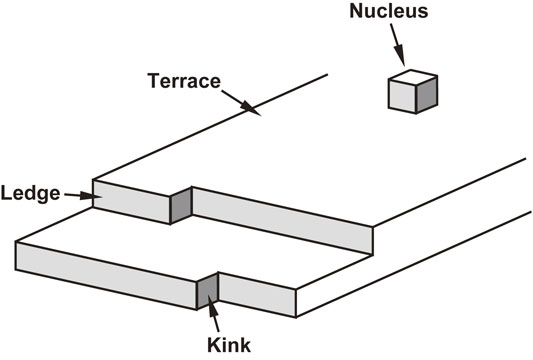
Matrix-precipitate interface illustrating the terrace-ledge-kink mechanism. Individual atoms are represented as cubes.
For the alloy peak-aged at 523 K for 10 h (Fig. 2), the thickness of the C15–Al2Ca precipitate corresponds to three stacks of the (0001)α basal plane of the α-Mg matrix. Moreover, the plate-like morphology is maintained for the alloy over-aged for 100 h (Fig. 3). Thus, the migration rate of the ledge and kink is faster than the heterogeneous nucleation rate on the terrace for the Al2Ca phase precipitated in the primary α-Mg grain of the alloy. The HRTEM image for the alloy aged at 573 K for 1 h, which is the over-aged condition at 573 K,15) is shown in Fig. 8. The Al2Ca phase with a flat planar surface precipitates coherently on the (0001)α basal plane of the α-Mg matrix, and the length and thickness of the precipitate are evaluated as 49 nm and 3 nm, respectively. The aspect ratio of the Al2Ca precipitate obtained by dividing the length of the precipitate by its thickness is 16 for the alloy aged at 573 K, which is obviously smaller than 28 identified for the specimen over-aged at 523 K (Fig. 3). The reduction of the aspect ratio of the Al2Ca precipitate at higher aging temperatures is considered to be caused by the dramatic increase of heterogeneous nucleation rate on the terrace relative to the increase of migration rate of the ledge and kink. The interface between the Al2Ca precipitate and the α-Mg matrix is obviously coherent, even if the precipitate length is 49 nm as shown in Fig. 8. Therefore, the critical length at which the coherence of the plate-like Al2Ca precipitate breaks down is presumed to be larger than 49 nm.
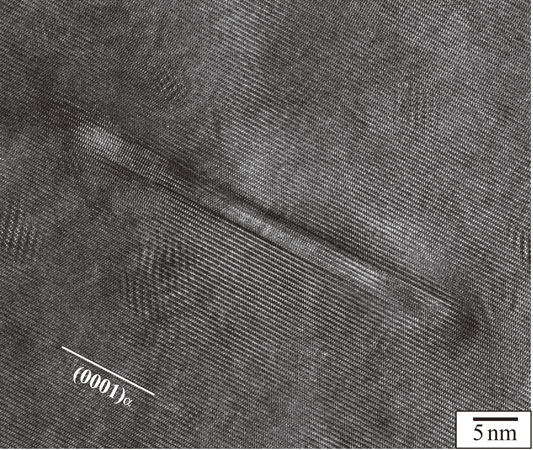
HRTEM image of coherent C15–Al2Ca precipitate observed in the Mg–5Al–1.5Ca alloy aged at 573 K for 1 h, taken with $\textbf{B} = [11\bar{2}0]_{\alpha }$.
Mg–5Al–1.5Ca alloy was subjected to aging treatment at 523 K, and the coarsening rate and coherence of the plate-like C15–Al2Ca precipitate were investigated in an over-aged condition through microstructure observation, using TEM and HRTEM. The following results were obtained:
The alloy samples used in this study were manufactured and provided by Mitsubishi Aluminum Co. The authors would like to thank Prof. Yoshisato Kimura of Tokyo Institute of Technology, and Mr. Kenji Ohkubo and Mr. Ryo Ota of Hokkaido University for their kind assistance with the microstructure observation using electron microscopy. One of the authors (Y. Terada) greatly appreciates the support from the Iketani Science and Technology Foundation and the Light Metal Educational Foundation. A part of this work was conducted at Hokkaido University, supported by the Nanotechnology Platform Program of the Ministry of Education, Culture, Sports, Science and Technology (MEXT), Japan.